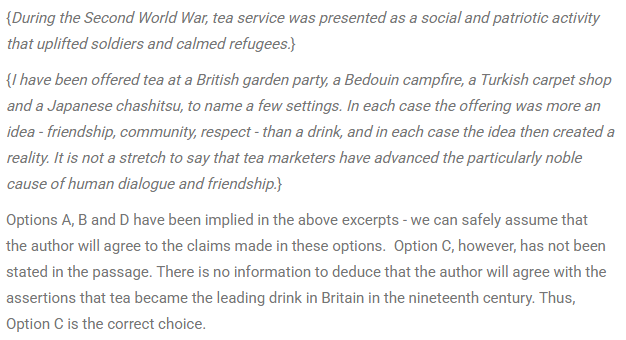CAT RC Questions | CAT RC- Social Science questions
FundaMakers is the Best CAT Online Coaching In India. Now prepare for CAT anytime with FundaMakers. We provide well-ordered syllabus coverage for both offline and online CAT preparation batches. FundaMakers brings to you the power-packed, well-structured CAT previous year question bank with more than 4000+ CAT Past Year questions. In the VARC section, one of the most frequently asked questions is from the topic- Reading Comprehension. Reading Comprehension turns out to be an important part of the VARC section from which over 60-70% of the questions are based on RC in the CAT Exam.
FundaMakers as a team has taken a painstaking step to bring you all the video solutions of the Reading Comprehension asked in the Previous Year CAT exam. CAT question bank offered by FundaMakers is a power-packed topic-wise compilation of the entire CAT previous year questions. Questions from the Reading Comprehension topic are some of the most scoring questions in the VARC section. To maximize your CAT score make use of FundaMakers CAT Question Bank. “Questions from CAT previous years” examination papers have been incorporated. Let’s get started with CAT Past Year Reading Comprehension Questions.
Comprehension
The passage below is accompanied by a set of questions. Choose the best answer to each question.
The sleights of hand that conflate consumption with virtue are a central theme in A Thirst for Empire, a sweeping and richly detailed history of tea by the historian Erika Rappaport. How did tea evolve from an obscure “China drink” to a universal beverage imbued with civilising properties? The answer, in brief, revolves around this conflation, not only by profit-motivated marketers but by a wide variety of interest groups. While abundant historical records have allowed the study of how tea itself moved from east to west, Rappaport is focused on the movement of the idea of tea to suit particular purposes.
Beginning in the 1700s, the temperance movement advocated for tea as a pleasure that cheered but did not inebriate, and industrialists soon borrowed this moral argument in advancing their case for free trade in tea (and hence more open markets for their textiles). Factory owners joined in, compelled by the cause of a sober workforce, while Christian missionaries discovered that tea “would soothe any colonial encounter”. During the Second World War, tea service was presented as a social and patriotic activity that uplifted soldiers and calmed refugees.
But it was tea’s consumer-directed marketing by importers and retailers – and later by brands – that most closely portends current trade debates. An early version of the “farm to table” movement was sparked by anti-Chinese sentiment and concerns over trade deficits, as well as by the reality and threat of adulterated tea containing dirt and hedge clippings. Lipton was soon advertising “from the Garden to Tea Cup” supply chains originating in British India and supervised by “educated Englishmen”. While tea marketing always presented direct consumer benefits (health, energy, relaxation), tea drinkers were also assured that they were participating in a larger noble project that advanced the causes of family, nation and civilization. . . .
Rappaport’s treatment of her subject is refreshingly apolitical. Indeed, it is a virtue that readers will be unable to guess her political orientation: both the miracle of markets and capitalism’s dark underbelly are evident in tea’s complex story, as are the complicated effects of British colonialism. . . . Commodity histories are now themselves commodities: recent works investigate cotton, salt, cod, sugar, chocolate, paper and milk. And morality marketing is now a commodity as well, applied to food, “fair trade” apparel and eco-tourism. Yet tea is, Rappaport makes clear, a world apart – an astonishing success story in which tea marketers not only succeeded in conveying a sense of moral elevation to the consumer but also arguably did advance the cause of civilisation and community.
I have been offered tea at a British garden party, a Bedouin campfire, a Turkish carpet shop and a Japanese chashitsu, to name a few settings. In each case the offering was more an idea – friendship, community, respect – than a drink, and in each case the idea then created a reality. It is not a stretch to say that tea marketers have advanced the particularly noble cause of human dialogue and friendship.
Explanatory Answer
Method of solving this CAT RC Question from RC- Social Science question
Correct Option: C

Hey!
Worried about IIM calls due to your marks in 10th,12th, and Graduation?
Don't worry! Know your chances of getting an IIM Call based on your profile with our:-
Profile Professor: https://fundamakers.com/profile-professor/

5 Must- NOT-Dos during CAT Preparation.
- Do not treat CAT as 'Everything'.
- Do not quit your job for CAT exam preparation.
- Learning till The Eleventh hour instead of doing proper revision.
- Not checking the syllabus thoroughly.
- Piling up multiple books.
Click To Read:- Common mistakes made by CAT aspirants during preparation.
FundaMakers- Best Online and Offline CAT Online Preparation Institute in India
For any CAT Preparation related query, reach out to us at 9598333344.